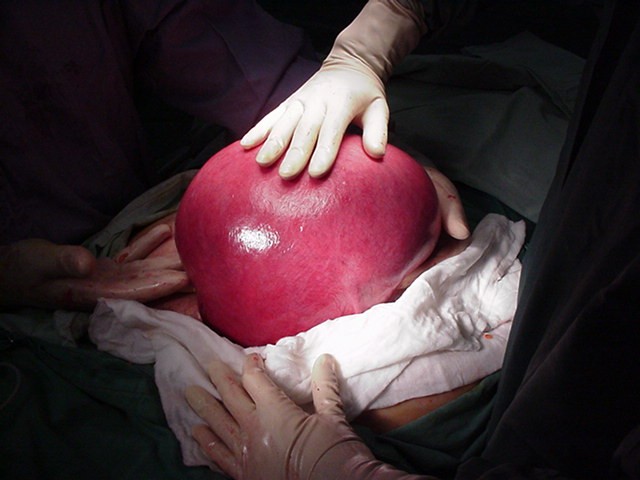Laparoscopy, Open Surgery Or…? Fertility Expert Enlightens On The Best Medical Procedure To Treat Fibroids

Fibroids in experts view are non-cancerous growths that develop in or around the womb (uterus). The growths are made up of muscle and fibrous tissue, and vary in size. They’re sometimes known as uterine myomas or leiomyomas.
Fibroids could be intramural fibroids – the most common type of fibroid, which develop in the muscle wall of the womb; subserosal fibroids – fibroids that develop outside the wall of the womb into the pelvis and can become very large and submucosal fibroids – fibroids that develop in the muscle layer beneath the womb’s inner lining and grow into the cavity of the womb.
In some cases, subserosal or submucosal fibroids are attached to the womb with a narrow stalk of tissue. These are known as pedunculated fibroids, says the National Health Service (NHS), United Kingdom.
Symptoms
Symptoms of fibroids vary in women. While in some it could be completely asymptomatic, some other 1 in 3 women may experience symptoms like heavy or painful periods, tummy (abdominal) pain, lower back aches, a frequent need to urinate, constipation, and pain or discomfort during sex. While in rare cases, complications of fibroids may lead to infertility.
Causes
Although it has been said to be the most common tumours of the uterus and female pelvis, experts have said that there are no known causes of fibroids; however, they have been linked to the hormone oestrogen.
Oestrogen is the female reproductive hormone produced by the ovaries (the female reproductive organs).
Fibroids usually develop during a woman’s reproductive years (from around the age of 16 to 50) when oestrogen levels are at their highest.
They tend to shrink when oestrogen levels are low, such as after the menopause, states the NHS. Aside these, research have revealed that fibroids often occur in women aged 30 to 50 and predominant in women of African-Caribbean origin.
Coming to the Nigerian context, the Tropical Journal of Obstetrics and Gynaecology in an article published in 2018 records that, they are estimated to occur in 20 to 50 per cent of women with increased frequency during the later reproductive years causing significant morbidity and reproductive ill-health.
The journal further stated that they are 3-9 times more common among black women of African descent than in Caucasians which indicates a strong association between race and ethnicity.
It is also thought they occur more often in overweight or obese women as being overweight increases the level of oestrogen in the body. While women who have had children have a lower risk of developing fibroids, and the risk decreases further the more children you have.
Treatment
Many women have had to try so many ways including concoctions to shrink fibroids, but experts have warned that such procedures only worsen the situation.
Chinyeaka Alozie is in a state of dilemma; she has been married for six years without a child to call her own and lots of pressure from both her family and her husband’s.
Two years into her marriage, she was diagnosed of fibroids. On her doctor’s advice, she went for surgical removal of the tumour, but four years on, there are no signs of pregnancy. And the most sympathetic part is that the fibroid is back and another surgery is imminent.
Ruth Komolafe’s case is quite different. She was diagnosed of fibroids in her 20s. She was however lucky enough to quickly get married and had a child, even though carrying the pregnancy was like a living hell due to the persistent pains she endured during the nine months period.
Ruth’s child is now eight and the tumour continues to grow. This has caused her some miscarriages as her doctor said the fibroid has taken the space from where the child ought to develop. Ruth has taken so many herbs, but they ended in futility. She is now considering a surgery to end the long walk to hospitals.
Ruth and Chinyeaka stories are just like a drop of water in the big ocean of women who are wallowing in the pools of infertility as a result of fibroids.
Recounting her ordeals, she said there was a time when she visited an herbal home and the result was almost disastrous. Her words:
“Because I was afraid of the surgical procedure recommended by every doctor I visited, I confided in a friend who took me to an herbal home. When we got there, the woman told me it was a small case, and told me how she had helped so many women.
I fell for her words and she gave me two portions, one for purging and the other to be taken close to my menstrual period.
She warned me to always stay indoors whenever I took the first one that it would cause me to purge out the fibroids in bits, while the other will also break them and they will flow out with my menses.
Honestly, the first was not a much problem, though it makes me purge so much sometimes, but the second experience was not palatable, I bled until I almost gave up. It took the interventions of doctors before I was revived.”
SEE ALSO: 6 Nigerian Women Detail Their Harrowing Fibroids Stories & How They Won The Battle Against All Odds
Treating fibroids with laparoscopy
There have been myths flying around about complications associated with removing fibroids through open surgical procedure, but the Managing Director, Nordica Fertility Centre, Dr. Abayomi Ajayi has allayed this fear. He has said that there was no need of going through the open surgical procedure when an endoscopy (laparoscopy) can be performed.
An endoscopy can be described as a minimally invasive procedure, which allows a key hole incision for a laparoscope to successfully address issues in the organ or tissue of focus. He also said the technology has a role to play in addressing endometriosis, ovarian cyst and other forms of infertility.
According to him, fibroids were better tackled laparoscopically than with open surgery if they are not too large, adding that the procedure was much cheaper and safer than open surgeries because it is associated with shorter hospital stay, as well as occurs with minimal blood loss. His words:
“A laparoscopy is used to diagnose and treat women with fertility problems. What this amount to be that a laparoscopy of the reproductive organs (a gynaecological laparoscopy) is quite often necessary.
In the past, this technique was not so readily available, but these days, the feasibility of laparoscopic surgery particularly in Nigeria is more common. This is fast gaining ground in Nigeria just like the rest of the world. It is cheaper, less complex and presumed safer than open access surgery and, hence, brightens the future of gynaecologic surgery.
Laparoscopy is now utilized to carry out virtually every medical procedure that can be done through open surgery in gynaecology, ranging from surgeries involving the uterus, fibroids, early stages of ovarian cancer, and difficulty in getting pregnant from blocked fallopian tubes.”
He also said that infertile couples trying to resolve their issues often stand to benefit from the procedure, while adding that, in selected couples with infertility from blocked fallopian tubes, surgery can be done laparoscopically in order for them to attain pregnancy.
The fertility expert, whose organisation is one of the few centres across Nigeria currently performing endoscopy, said if wombs have to be removed for any reason, they could be done laparoscopically. He added:
“Clinically, this procedure is almost infinitely useful in gynaecology practice particularly because the trauma of opening somebody up with a wide incision and the challenge of recovery afterwards is completely removed. The opening is minimal just like a “keyhole” and it allows the body to recover much faster unlike opening up the womb through the normal traditional method, in which you would have been on admission for a number of days, but in laparoscopy, you can return home within 24 hours.”
Pointing out that the most common cause of female infertility in Nigeria is tubal blockage as a result of infections, Ajayi noted that the advantage of laparoscopy was that when used for diagnosis, it can also be used to treat, adding that the limitations were often the expertise and experience of the surgeons.
“During a gynaecological laparoscopy, a small incision will be made in the abdomen – small is good for risk reduction and recovery – and then a tube with light and camera attached (laparoscope) is guided into the pelvic area.
“Secondary incisions may also be made nearby, allowing small surgical tools and gas to be pumped in, creating a better view of the reproductive organs. The aim is to seek out cysts, fibroids, endometriosis, ectopic pregnancies, pelvic inflammatory disease, adhesions, infections and other issues that may be affecting fertility.
It lasts up to 60-90 minutes, depending on what’s done. Depending on the procedure patient may go home after a few hours in the recovery room,” the fertility expert enlightened.
How laparoscopy can address endometriosis
He said many couples with unexplained infertility could benefit from laparoscopy to check for abnormalities in the woman, with conditions such as endometriosis picked up through the technology.
While noting that endometriosis cannot be cured, he said that it could be managed through non-invasive procedures before surgery. He said:
“If you are trying to get pregnant, the treatment option is usually either surgery or IVF as medication used for endometriosis usually stops ovulation and therefore prevents pregnancy. So, laparoscopy is usually the surgery of choice to treat endometriosis. It involves removing the endometrial growths while protecting the ovaries and uterus.”
He said if unfortunately, endometriosis surgery didn’t result in pregnancy, the female could as well freeze her eggs or try other options of assisted reproduction techniques (ART).
SEE ALSO: Good News! New Oral Treatment For Uterine Fibroids Can Shrink The Tumour And May Replace Surgery
“The bottom line is that getting pregnant after laparoscopy is improved. In early-stage endometriosis, it is useful to help diagnose and treat women with infertility problems. A laparoscopy can therefore be operative, not just diagnostic. “Meaning that if something is found wrong, it can be dealt with there and then.
Some tubal repairs may be unnecessary in the face of IVF technology. But if you have had one or two failed IVF cycles, you will want to do everything you can to get to the root of the problem,” the fertility expert added.


